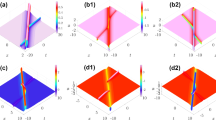Abstract
In this paper, we focus on two different points. Firstly, the Lie symmetry analysis is presented for a coupled short pulse system which describes the propagation of two orthogonally polarized modes in optical fibers. Then the similarity reductions and exact solutions of the system are performed based on the optimal systems. Secondly, the explicit solutions are constructed by the power series method. Moreover, the convergence of the power series solutions are discussed. Such power series solutions and similarity reductions are important in both applications and the theory of nonlinear waves.

Similar content being viewed by others
References
Schäfer, T., Wayne, C.E.: Propagation of ultra-short optical pulses in cubic nonlinear media. Phys. D 196, 90–105 (2004)
Robelo, M.L.: On equations which describe pseudospherical surfaces. Stud. Appl. Math. 81, 221–248 (1989)
Matsuno, Y.: Multisoliton and multibreather solutions of the short pulse model equation. J. Phys. Soc. Jpn. 76, 084003 (2007)
Parkes, E.J.: Some periodic and solitary travelling-wave solutions of the short-pulse equation. Chaos Solitons Fract. 38, 154–159 (2008)
Kuetche, V.K., Bouetou, T.B., Kofane, T.C.: On Two-loop soliton solution of the Schäfer–Wayne short-pulse equation using Hirota’s method and Hodnett–Moloney approach. J. Phys. Soc. Jpn. 76, 2062–2075 (2007)
Kurt, L., Chung, Y., Schäfer, T.: Higher-order corrections to the short pulse equation. J. Phys. A Math. Theor. 46, 3739–3744 (2012)
Sakovich, S.: Integrability of the vector short pulse equation. J. Phys. Soc. Jpn. 77, 123001 (2008)
Matsuno, Y.: A novel multi-component generalization of the short pulse equation and its multisoliton solutions. J. Math. Phys. 52, 123702 (2011)
Brunelli, J.C., Sakovich, S.: Hamiltonian integrability of two-component short pulse equations. J. Math. Phys. 54, 012701 (2012)
Kuetche, V.K., Bouetou, T.B., Kofane, T.C.: On the conversion of exact rotating loop-like soliton solution to generalized Schäfer–Wayne short pulse equation. J. Phys. Soc. Jpn. 76, 073001 (2007)
Youssoufa, S., Kuetche, V.K., Kofane, T.C.: Generation of a new coupled ultra-short pulse system from a group theoretical viewpoint: the cartan ehresman connection. Chin. Phys. Lett. 29(2), 020202 (2012)
Gardner, C.S., Greene, J.M., Kruskal, M.D., Miura, R.M.: Method for solving the Korteweg–de Vries equation. Phys. Rev. Lett. 19, 1095–1097 (1967)
Hirota, R., Satsuma, J.: A variety of nonlinear network equations generated from the Bäcklund transformation for the Tota lattice. Suppl. Prog. Theor. Phys. 59, 64–100 (1976)
Wazwaz, A.M., El-Tantawy, S.A.: New (\(3+1\))-dimensional equations of Burgers type and Sharma–Tasso–Olver type: multiple-soliton solutions. Nonlinear Dyn. 87, 2457–2461 (2017)
Wazwaz, A.M., El-Tantawy, S.A.: A new integrable (\(3+1\))-dimensional KdV-like model with its multiple-soliton solutions. Nonlinear Dyn. 83, 1529–1534 (2016)
Li, Y.S.: Soliton and integrable systems. In: Advanced Series in Nonlinear Science. Shanghai Scientific and Technological Education Publishing House, Shang Hai (1999) (in Chinese)
Lu, K., Ma, W.X., Yu, J., Lin, F.H., Khalique, C.M.: Envelope bright- and dark-soliton solutions for the Gerdjikov–Ivanov model. Nonlinear Dyn. 82, 1211–1220 (2015)
Olver, P.J.: Applications of Lie Groups to Differential Equations. In: Graduate Texts in Mathematics. Springer, New York(1993)
Bluman, G.W., Kumei, S.: Symmetries and Differential Equations. Springer, Berlin (1989)
Cantwell, B.J.: Introduction to Symmetry Analysis. Cambridge University Press, Cambridge (2002)
Clarkson, P., Kruskal, M.: New similarity reductions of the Boussinesp equation. J. Math. Phys. 30, 2201–2213 (1989)
Clarkson, P.: New similarity reductions for the Modified Boussinesp equation. J. Phys. A Gen. 22, 2355–2367 (1989)
Bluman, G.W., Anco, S.C.: Symmetry and Integration Methods for Differential Equations. Springer, New York (2004)
Ovsiannikov, L.V.: Group Analysis of Differential Equations. Academic Press, New York (1982)
Grigoriev, Y.N., Kovalev, V.F., Meleshko, S.V.: Symmetries of Integro-differential Equations: with Applications in Mechanics and Plasma Physics. Springer, New York (2010)
Abdulwahhab, M.A.: Optimal system and exact solutions for the generalized system of 2-dimensional Burgers equations with infinite Reynolds number. Commun. Nonlinear Sci. Numer. Simul. 20, 98–112 (2015)
Asmar, N.H.: Partial Differential Equations with Fourier Series and Boundary Value Problems. China Machine Press, Beijing (2005)
Rudin, W.: Principles of Mathematical Analysis. China Machine Press, Beijing (2004)
Acknowledgements
This research was supported by Scientific and Technological Innovation Programs of Higher Education Institutions in Shanxi (No. 2017116).
Author information
Authors and Affiliations
Corresponding author
Rights and permissions
About this article
Cite this article
Gao, B., He, C. Analysis of a coupled short pulse system via symmetry method. Nonlinear Dyn 90, 2627–2636 (2017). https://doi.org/10.1007/s11071-017-3827-0
Received:
Accepted:
Published:
Issue Date:
DOI: https://doi.org/10.1007/s11071-017-3827-0



